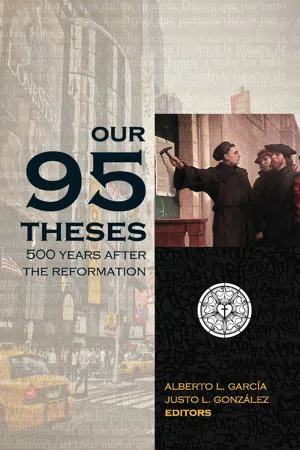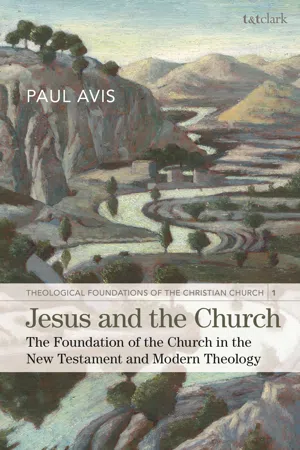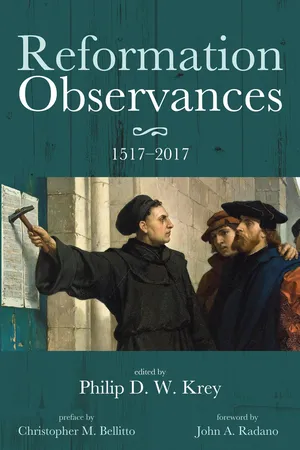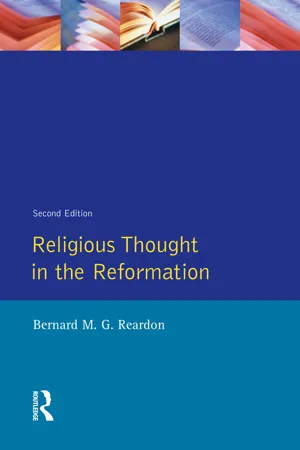History
Lutheran Church
The Lutheran Church is a major Protestant denomination that traces its roots to the teachings of Martin Luther in the 16th century. Lutheranism emphasizes the authority of the Bible, salvation by grace through faith, and the priesthood of all believers. It has had a significant impact on the history of Christianity, particularly during the Reformation period.
Written by Perlego with AI-assistance
Related key terms
Related key terms
1 of 4
Related key terms
1 of 3
4 Key excerpts on "Lutheran Church"
- eBook - ePub
Our Ninety-Five Theses
500 Years after the Reformation
- Alberto L. García, Justo L. González(Authors)
- 2016(Publication Date)
- Bestsellers Media(Publisher)
2. The legacy of the Reformationshows us the rich appropriation of the cultural focus of the Renaissance era in the study of the sources and classic texts, as well as the use of polyphonic music as sources that formed the impetus for the translation of the Bible into the language of the people and the use of polyphonic music in the congregational context. There are expressions of Lutheranism in some parts of the world that have learned to incarnate the spoken and heartfelt musical language of the people, taking into account at the same time the questions and worldview of that culture in the catechetical instruction.Nevertheless, in certain parts of Latin America we see Lutheranism as a German immigrant phenomenon that exists relatively isolated from the rest of the Latino population with its own aspirations and problems. Another form of aberration is to see Lutheranism in Latin America as a North American missionary movement that, though well intentioned, tends to form leaders whose language and thought processes tend to reflect the Lutheran Churches of North America and not Latin America. For historical and cultural reasons, the Lutheran Church in the United States continues to be one of the churches with the lowest number of Latinos in the entire country. In the face of these challenges, the Lutheran Church has to rediscover its historic disposition toward incarnating in the culture of the people, rejoicing in and evangelically appropriating those cultural expressions that promote the teaching of the Word of God and life in community.3. Luther understands the functionof temporal government in the promotion of peace and order in the society as a gift of God. He also teaches that in the spiritual realm (that is of the Holy Spirit), God redeems his creation by means of the Gospel of justification. Luther distinguishes between the two kingdoms, yet relates them because the Christian lives by faith in this world and has to live out his or her vocation in this world. Nevertheless, the distinction between the temporal and spiritual kingdoms has been used to justify the status quo of the temporal government even when it is not functioning or does not take into account the welfare of significant parts of its population. As long as we assume that only the spiritual welfare within the spiritual kingdom is important, and are not concerned with what happens in everyday life, such an action can lead to a justification of injustices that affect the most vulnerable (or at least a lack of interest in their wellbeing). - eBook - ePub
Jesus and the Church
The Foundation of the Church in the New Testament and Modern Theology
- Paul Avis(Author)
- 2020(Publication Date)
- T&T Clark(Publisher)
6 The foundation of the church in Protestant theology Towards a critical revolutionThe creative impulse behind the theology of the Reformation was the power of the biblical word – especially in the form of the preached gospel – to reform and renew the church. These biblical and patristic texts were approached employing the methods of Renaissance Humanism (the study of humane literature). It is perhaps not too much to claim that the Reformers were critical scholars according to their lights. From the first, Protestant scholarship was receptive to critical-historical methods in principle.1For Martin Luther in particular, the church was the dynamic creation of the word, creatura verbi , including the sacramental word.2However, Protestant theology lost much of its dynamism in the seventeenth century. It developed three retrograde characteristics: (a) a complacent acceptance, on the part of many, of the existing divisions in the church (between the Roman Catholic Church and the Reformation churches, on the one hand, and within Protestantism, between the Lutheran and the Reformed churches, on the other); (b) a confessionalism with regard to the identity of the church and its theology that tended to treat, for example, the Lutheran Augsburg Confession (1530) and the Formula of Concord (1577) and the Reformed Heidelberg Catechism (1563) or the articles of the Synod of Dort (1618–19) in practice as on the same level of authority as Holy Scripture; and (c) a movement towards a basically scholastic model of theological method that promoted logical analysis and systematic coherence, along with an exaggerated emphasis on doctrinal precision.In the late seventeenth and early eighteenth centuries the movement of spiritual vitality known as pietism, led by P. J. Spener and A. H. Franke, reacted against what it regarded as the dead orthodoxy of the Lutheran Church in Germany. In its spiritual rigour and fervent devotion, it prepared the ground for a renewal of ecclesiology. That renewal came in the work of F. D. E. Schleiermacher, himself a spiritual son of pietism in the form of the Moravian movement. Schleiermacher retrieved the authentic impulse of Reformation theology by approaching Christian doctrine in an existential and pastoral way. Protestant ecclesiology typically stresses the inward, spiritual reality of the church and is suspicious of the institutional, societal and hierarchical model favoured by Catholics (both Roman and Anglican). Schleiermacher was an outstanding critical scholar of the Bible, but his distinctive approach, which is typical of Protestantism, renders ecclesiology less vulnerable to a critique informed by the eschatological horizon of the New Testament. - eBook - ePub
- Krey(Author)
- 2017(Publication Date)
- Cascade Books(Publisher)
Such “good news,” the gospel, is part of a dialectic with the “law.” It leads to repentance, preceded by spiritual anxiety and suffering (Anfechtung); the gospel leads to salvation fully realized after Christ’s second coming. But Luther was sliding into a theological speculation about the Jews against his better judgment grounded in Paul, namely, that faith in Christ can never “justify “the divine punishment of the Jews. They, together with the Christian Gentiles, share the interim leading to a full union when Christ will come again. 64 The Luther Renaissance and the study of Luther’s writings in his context also revealed his indebtedness to the tradition which he both criticized and appropriated. There was an explosion of Luther biographies in the twentieth century. 65 Scholars like Heiko Oberman also showed through intense research of late-medieval theology that Luther both continues and broke with theological debates that prevailed in the schools before him. 66 Like other great reformers before him Augustine and Aquinas through intense scholarship, life as a monk and priest and professor, prayer, and reading—no devouring texts—he plumbed them and came out having turned them upside down and renewed. Scholars of the twentieth century began to recognize the value and contribution of the tradition and Luther’s appreciation for it so that he needed not always represent the liberal ideals of newness and human progress but no matter how radical—retrieval and preservation of the message of Paul and to some extent a revision of Augustine. 67 This same century which became the ecumenical century launched the mergers of Lutheran denominations in the United States and around the world and was also the century in which the Lutheran World Federation was formed (1947). 68 There was a growing sense that the Lutheran movement had become an ecumenical movement in the church catholic and by the power of the Holy Spirit the rifts of sixteenth century could be healed - eBook - ePub
- Bernard M. G. Reardon(Author)
- 2014(Publication Date)
- Routledge(Publisher)
In this aspect the ideal Christian community is always in process of becoming, of being built up. Externally realized, it is recognizable as the corpus Christianum, reaching out to embrace the whole social life of the community; and it is because society can be thus Christianized that it is possible for the communion of true believers to live and grow. But nature and history have brought into being certain orders or hierarchies (Ordnungen), as Luther called them, namely the family (oeconomia), which is the basic natural ‘order’, the state or magistracy (politia), the protective order, and the church (ecclesia), the spiritual order. All these orders have their rights and proper authority, through whose interaction the communio sanctorum can exist and manifest itself among men. Luther’s faith in the Word, then, obliged him, in the actual historical situation in which he found himself, to work out a doctrine of the church in many regards strikingly different from that on which contemporary Catholic practice rested. He did so, however, in no spirit of iconoclasm – he agonized over the question whether he alone could be right and all the Catholic teachers before him wrong 36 – but in the conviction that he was cleansing not destroying, correcting not abolishing, and that the reformed church he envisaged and sought to bring about would be not simply a return, per saltum as it were, to the church of the New Testament, but a continuation of that whose life and fundamental witness to the truth in Christ Jesus had persisted through the centuries. At first it was his hope and even expectation that the Roman papacy itself would awaken to the true light of the gospel. These were dashed when he and his followers were denounced and excommunicated. The upshot was the establishment of new institutions devised in accordance with the principles which his reading of the scriptures had led him to embrace. Thus ‘Lutheran’ churches came into being, embodying a reformed order of their own
Index pages curate the most relevant extracts from our library of academic textbooks. They’ve been created using an in-house natural language model (NLM), each adding context and meaning to key research topics.
Explore more topic indexes
Explore more topic indexes
1 of 6
Explore more topic indexes
1 of 4



